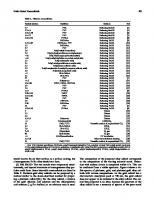Noble Metal Nanoparticles 1588830640
357 51 2MB
English Pages 32 Year 2004
Recommend Papers

- Similar Topics
- Technique
- Nanotechnology
File loading please wait...
Citation preview
Encyclopedia of Nanoscience and Nanotechnology
www.aspbs.com/enn
Noble Metal Nanoparticles Yiwei Tan, Yongfang Li, Daoben Zhu Chinese Academy of Sciences, Beijing, People’s Republic of China
CONTENTS 1. Introduction 2. Synthesis 3. Spectroscopic Characterization 4. Properties 5. Self-Assembly 6. Applications 7. Summary Glossary References
1. INTRODUCTION During the final decade of the 20th century, nanomaterials were the focus of research in the field of materials science, which is driven by the expectations concerning the application of nanomaterials as a forthcoming generation of functional materials for the new century. A large amount of knowledge about the synthesis and properties of various nanoparticles and nanocomposites was accumulated within such a short period, with numerous new insights and techniques emerging with each passing day. The physical and chemical properties of substances can be significantly altered when they are exhibited on a nanometer-length scale, and this phenomenon opens up a completely new perspective for materials design that benefits from the introduction of not only particle size, but also particle morphology as new, powerful parameters. A brand new concept is arising in material science: to utilize nanoparticles as the building blocks to displace the conventional microdevices by nanodevices. This challenging innovation will give rise to a revolutionary development: a drastic reduction in the necessary amount of traditional materials, subsequently of the cost and pollution, and finally turning the modern manufacturing that is regarded as an industry of exhausted natural resources and environmental harm into “smart and green production.” The substances with one dimension shrinking down to 1–100 nm can be called nanoscale substances. The nanomaterials can display various geometrical morphologies, ISBN: 1-58883-064-0/$35.00 Copyright © 2004 by American Scientific Publishers All rights of reproduction in any form reserved.
which include zero-dimensional nanoparticles with an aspect ratio approximately equal to 1, one-dimensional nanorods (aspect ratio > 1), nanowires, nanofibers, nanotubes, and nanoribbons or nanobelts [1, 2], two-dimensional nanosheets [3–5] and nanoscale diskettes [6], and three-dimensional nanocages [7, 8]. Nanoparticles are the most thermodynamically stable form with respect to the other geometrically morphological nanoscale materials because they have the least surface energy. Having sizes located between those of small molecules (








![Metal Nanoparticles in Microbiology [1 ed.]
3642183115, 9783642183119](https://ebin.pub/img/200x200/metal-nanoparticles-in-microbiology-1nbsped-3642183115-9783642183119.jpg)
